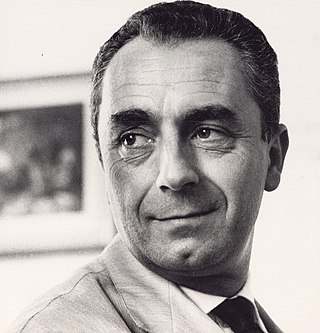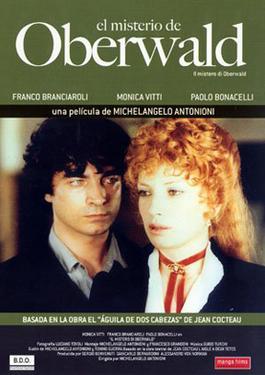
Michelangelo Antonioni was an Italian director and filmmaker. He is best known for his "trilogy on modernity and its discontents"—L'Avventura (1960), La Notte (1961), and L'Eclisse (1962), the English-language film Blowup (1966) and the multilingual The Passenger (1975). His films have been described as "enigmatic and intricate mood pieces" that feature elusive plots, striking visual composition, and a preoccupation with modern landscapes. His work substantially influenced subsequent art cinema. Antonioni received numerous awards and nominations throughout his career, being the only director to have won the Palme d'Or, the Golden Lion, the Golden Bear and the Golden Leopard.

Emilia-Romagna is an administrative region of northern Italy, comprising the historical regions of Emilia and Romagna. Its capital is Bologna. It has an area of 22,446 km2 (8,666 sq mi), and a population of 4.4 million.

L'Avventura is a 1960 drama film directed by Michelangelo Antonioni. Developed from a story by Antonioni with co-writers Elio Bartolini and Tonino Guerra, the film is about the disappearance of a young woman during a boating trip in the Mediterranean, and the subsequent search for her by her lover and her best friend. It was filmed on location in Rome, the Aeolian Islands, and Sicily in 1959 under difficult financial and physical conditions. The film is noted for its unusual pacing, which emphasizes visual composition, mood, and character over traditional narrative development.

Zabriskie Point is a 1970 American drama film directed by Michelangelo Antonioni and starring Mark Frechette, Daria Halprin, and Rod Taylor. It was widely noted at the time for its setting in the counterculture of the United States. Some of the movie's scenes were filmed on location at Zabriskie Point in Death Valley. The movie was an overwhelming commercial failure, and was panned by most critics upon release.

Maria Luisa Ceciarelli, known professionally as Monica Vitti, was an Italian actress who starred in several award-winning films directed by Michelangelo Antonioni during the 1960s. She appeared with Marcello Mastroianni, Alain Delon, Richard Harris, Terence Stamp, and Dirk Bogarde. On her death, Italian culture minister Dario Franceschini called her "the Queen of Italian cinema".

L'Eclisse is a 1962 romantic drama film co-written and directed by Michelangelo Antonioni and starring Alain Delon and Monica Vitti, with Francisco Rabal, Lilla Brignone, and Louis Seigner. Filmed on location in Rome and Verona, the story follows a young woman (Vitti) who pursues an affair with a confident young stockbroker (Delon). Antonioni attributed some of his inspiration for L'Eclisse to when he filmed a solar eclipse in Florence. The film is considered the last part of a trilogy and is preceded by L'Avventura (1960) and La Notte (1961).

Love in the City is a 1953 Italian anthology film composed of six segments, each with its own director. The segments and filmmakers are: Paid Love, Attempted Suicide, Paradise for Three Hours, Marriage Agency, Story of Caterina, and Italians Stare.

Modesty Blaise is a 1966 British spy-fi comedy film directed by Joseph Losey, produced by Joseph Janni, and loosely based on the popular comic strip Modesty Blaise by Peter O'Donnell, who co-wrote the original story upon which Evan Jones and Harold Pinter based their screenplay. It stars Monica Vitti as "Modesty", opposite Terence Stamp as Willie Garvin and Dirk Bogarde as her nemesis Gabriel. The cast also includes Harry Andrews, Michael Craig, Alexander Knox, Rossella Falk, Clive Revill, and Tina Aumont. The film's music was composed by Johnny Dankworth and the theme song, Modesty, sung by pop duo David and Jonathan. It was Vitti's first English-speaking role.

La Notte is a 1961 drama film co-written and directed by Michelangelo Antonioni and starring Marcello Mastroianni, Jeanne Moreau and Monica Vitti. Filmed on location in Milan, the film depicts a single day and night in the lives of a disillusioned novelist (Mastroianni) and his alienated wife (Moreau) as they move through various social circles. The film continues Antonioni's tradition of abandoning traditional storytelling in favor of visual composition, atmosphere, and mood.
The Nastro d'Argento for Best Director is a film award bestowed annually as part of the Nastro d'Argento awards since 1946, organized by the Italian National Association of Film Journalists, the national association of Italian film critics.

Story of a Love Affair, released in the United Kingdom as Chronicle of a Love, is a 1950 Italian drama film directed by Michelangelo Antonioni in his feature-length directorial debut. The film stars Massimo Girotti and Lucia Bosè in lead roles. Despite some neorealist background, the film was not fully compliant with the contemporary Italian neorealist style both in its story and image, featuring upper-class characters portrayed by professional actors. Ferdinando Sarmi was, however, a fashion designer rather than a professional actor. Its story was inspired by the James M. Cain novel The Postman Always Rings Twice. In the film, the camera pans the same street corner in Ferrara, the director's native city, that appears in his film Beyond the Clouds forty-five years later. In 1951, the film won the Nastro d'Argento Award for Best Original Score and the Special Nastro d'Argento for "human and stylistic values".
Giovanni Fusco was an Italian composer, pianist and conductor, who has written numerous film scores since 1936, including those of Alain Resnais's Hiroshima mon amour (1959) and La guerre est finie (1966), as well as those of most of the 1948-1964 films directed by Michelangelo Antonioni, from N.U. to Il deserto rosso, except for La notte and some of his early short films. Two of his soundtracks, those of Antonioni's Cronaca di un amore and L'avventura, won Silver Ribbon for the best film score from Italian National Syndicate of Film Journalists in 1951 and 1961, respectively.

Carlo Di Palma was an Italian cinematographer, renowned for his work on both color and black-and-white films, whose most famous collaborations were with Michelangelo Antonioni and Woody Allen.

Il grido is a 1957 Italian drama film directed by Michelangelo Antonioni and starring Steve Cochran, Alida Valli, and Betsy Blair. It received the Golden Leopard at the 1957 Locarno Film Festival. In 2008, the film was included on the Italian Ministry of Cultural Heritage’s 100 Italian films to be saved, a list of 100 films that "have changed the collective memory of the country between 1942 and 1978."

The Mystery of Oberwald is a 1980 Italian–German television drama film directed by Michelangelo Antonioni and starring Monica Vitti, Paolo Bonacelli, and Franco Branciaroli. It is based on the 1946 play L'Aigle à deux têtes by Jean Cocteau.

Anna Maria Ferrero was an Italian actress.

Beyond the Clouds is a 1995 Italian-French-German romance film directed by Michelangelo Antonioni, with contributions by Wim Wenders, and starring John Malkovich, Sophie Marceau, Vincent Perez, Irène Jacob, Fanny Ardant, Jeanne Moreau, Peter Weller, Marcello Mastroianni, and Jean Reno. The film consists of four stories of romantic love and illusion told from the perspective of a wandering film director. In the first story, two beautiful young lovers are unable to consummate their passion because the young man desires impossible perfection. In the second story, the director makes love to a young woman who reveals that she murdered her father. In the third story, a man makes an effort to appease both his wife and his mistress. In the fourth story, a young man is infatuated with a girl who is about to enter a convent. This was the final feature-length film by Antonioni before his death in 2007.

Help Me, My Love is a 1969 Commedia all'italiana film written, directed and starred by Alberto Sordi.

Rita Carla Francesca Monticelli is an Italian science fiction and thriller author. Born in Carbonia in 1974, she has been living in Cagliari since 1993, where she works as a writer, as well as scientific and literary translator.

Xenia Valderi was a Dalmatian Italian actress.




















